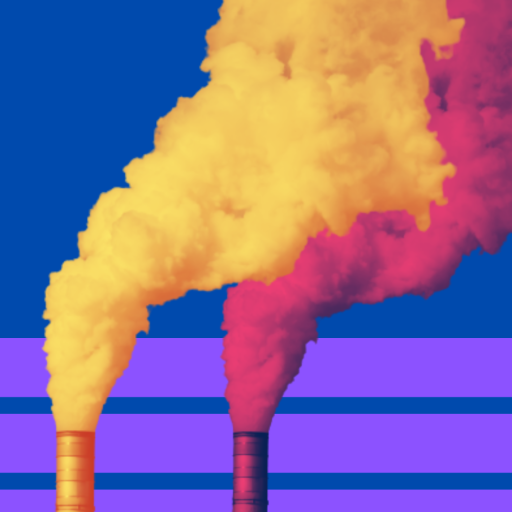Air Pollution Which Causes Diseases and Death in Dilovası
6 Aralık 2022Liza Olgar
Threatening subversions of the world’s ecosystem and humankind are caused by air pollution. The pollution brings about several health issues, such as nose and eyes issues, scalded throat, and breathing problems. Also, air pollution can cause congenital disabilities, cancer, damage to nerves and the brain, and long-time damage to the lungs and the environment. These health problems might be as severe as to be leading to death. Since the WHO approximated that those 4.6 million deaths occurred per year caused directly by air pollution, leading to the conclusion that it affects people, ecosystems, and all living things, finally making air pollution a major focus (Kaya & Kahraman, 2011). Due to the factories established in industrialization areas, the people living in those areas are more affected by air pollution due to the fumes coming from factory wastes. When these people are affected by them, disease and death rates increase, as how happened in Dilovası. Thus, air pollution is one of the biggest threats to the environment in urban areas since it threatens to harm habitats, plants, structures, and substances in addition to individuals (Kaya & Kahraman, 2011). I argue that this case speaks to concepts such as the sacrifice zone and environmental injustice because of air pollution in Dilovası.
While people living in other parts of Turkey are less affected by the air pollution caused by these factories, the poor people who live in Dilovası are considerably affected. Even though the rate of industrialization is high in the area, low-income people are forced to live there because of their financial impossibilities, making Dilovası a sacrifice zone. Because of the pollution caused by the industries, disease and mortality rates are increased in Dilovası and similar high-industrialization zones. Thus, this leads to environmental inequality. The ecological environment of urban living is influenced by socioeconomic level. Poorer areas have less attractive urban settings and commonly become victims of environmental damage (Short, 2013), like Dilovası, which has a sacrifice zone and industrial area. Thus, environmental injustice plays an important part in Dilovası.
Pollution of the environment has been a worldwide concern that has a negative effect on health. Industrialization and urbanization are the two main factors of pollution in the environment (Hamzaoğlu et al., 2014). The pollution generated by industry has resulted in the emergence of new diseases in recent decades, altering death rates and patterns. The most well-known area in Turkey with high air pollution is Dilovası, where the industrialization rate is very high. The rate of deaths because of cancer is three times greater than both public and world data registrations because of the air pollution condition in Dilovası, which is generated by many factories located in the city near the places where people live (Hamzaoğlu et al., 2011). The link between air pollution and cancer is well established, so cancer occurrences were shown to be higher in more polluted areas. For example, cancer is said to be responsible for 12.5% of all fatalities globally, including 13% in Turkey (Hamzaoğlu et al., 2011). In a study of the Dilovası Government’s grave registration performed in the past decade, cancer was revealed to be the reason for 161 fatalities or 32% of the total 505 (Hamzaoğlu et al., 2011). In Dilovası, an industrial area of Turkey, people’s health is deteriorating, and death rates are increasing due to air pollution. Most of the population living there complain about this situation, but because most people living in that area are poor, they cannot move to live elsewhere (Karagence, 2022). For instance, the Karagence’s survey, Karagence emphasized that people are not satisfied with where they live;
There’s probably no need to experiment with environmental pollution here. We live in an area surrounded by industry. Of course, we will be affected. Here, we sense pollution through our five senses. Sometimes we feel our nose burning. We can’t breathe when there are strong odors. I’m not even talking about visual pollution; it is obvious. Noise pollution as well; it is not possible to stay out when some factories operate it is that loud. (p. 82)
According to Ragıp, who lives in Dilovası and is quoted here, this industrial pollution can negatively affect every citizen, and the pollution in Dilovası is visible and damaging, which shows that a lot of people are affected by the pollution there and that many people are aware of this pollution and the diseases that follow. In short, there is more air pollution in industrialized areas such as Dilovası, and this pollution harms the health of the people who are living there, the death rate is increasing, and the people living in these areas cannot be moved to other places because they are generally low-income people (Karagence, 2022). This indicates that Dilovası has Sacrifice Zones because poor people live in this area, and there is much industrial pollution. Also, this results in environmental injustice because there are no wealthy people, only poor people living there.
On the other hand, many people go to Dilovası from different areas to find a job in factories to earn money (Karagence, 2022). Due to unemployment and hunger problems, most people are constrained to find employment in industrial areas such as Dilovası and migrate to live in those areas because of the economic issues. People who think that they can find job opportunities in industrial areas not only give up their lifestyles but also lose their health because of air pollution caused by industrialization. For instance, Ahmet’s interview shows that many people went to Dilovası to work there because of unemployment (Karagence, 2022);
We have been living in Dilovası almost for 30 years. After completing my education, we moved to Dilovası as a family because of the job shortage in the Black Sea region. We had the chance to go to a better place, but we thought that job opportunities would be higher in Dilovası. When we arrived, many people also came with these feelings. (p. 77)
This survey shows that for people who do not have money, Dilovası provides support to poor people by giving them jobs. Still, because they earn low cash in their jobs, Dilovası generally hosts low-income people because high-income people are already running away from Dilovası due to air pollution. This is the most prominent example of environmental inequality because Dilovası, one of the sacrifice zones, has become a living space only for low-income people. While people with higher incomes migrate from Dilovası, one of the areas where industrialization is high, people with low incomes move to live there out of necessity.
The percentage of deaths attributable to cancer is more considerable in Dilovası, where residential and industrial zones are quite close (Hamzaoğlu et al., 2011). Thus, it has been figured out that the areas where people live and industries are closely intertwined in the Dilovası region, which explains the health problems and mortality rates of the people living there. Dilovası, also known as “Cancer Valley,” has five organized industrial areas and one industrial zone. Despite Dilovası being 118 km2, factories account for 40 percent of the total surface, while residents account for just 25 percent (Karagence, 2022). Therefore, cancer was shown to be the cause of 33 of every 100 fatalities in Dilovası (Karagence, 2022). According to the study, people who stayed in Dilovası for longer than a decade had a higher probability of 4.4 percent of dying from cancer, and this is due to industries that make up 40 percent of that area. In short, with the increase in population due to job opportunities, unplanned urbanization has occurred in Dilovası (Yavuz & Tanık, 2011). Thus, the industrial zones and the region where people live have become intertwined, leading to increased diseases and mortality rates. Poor people who live in Dilovası with unplanned urbanization areas between factories and homes have a lot of health problems. While wealthy people prefer to live outside these areas, poor people have to live there because they don’t have money to go outside, indicating environmental inequality.
Many surveys show that the environment is responsible for 20-80 percent of all illnesses. According to the WHO, external conditions cause 80 percent of overall cancer, either explicitly or implicitly (Yavuz & Tanık, 2011). One of the most important causes of environmental pollution is industrialization; as a result of the formation of wastes and toxic substances in factories, environmental pollution has increased and started to harm people’s lives. Chemical pollutants generated by industry have altered death and illness rates, resulting in the emergence of new diseases in recent years. Toxic waste emerges from industrial pollution, and in Dilovası, almost 10 percent of Turkey’s 500 big enterprises are located (Yavuz & Tanık, 2011). Metal is often used by 38 percent of the companies in Dilovası Organized Industrial Zone, the chemical is being used by 20 percent, storage can be used by 13 percent, and mining is still used by 7 percent (Yavuz & Tanık, 2011). Also, metal, cement, paper, petroleum, and chemical are the most polluting industrial sectors (Yavuz & Tanık, 2011). That’s why so many toxic substances come out, the air is polluted, people’s health is damaged, and death rates increase in Dilovası because of poverty. This is an indicator of environmental inequality because poor people cannot go anywhere out of Dilovası to be away from air pollution.
Looking at this situation from the political ecology point of view, people living here, which has a sacrifice zone, are subjected to environmental inequalities compared to those living elsewhere due to air pollution. Since those living in Dilovası are generally from low-income families, they cannot even go anywhere else to live in better conditions and must work in those factories to earn money. Thus, they face many health problems because they work and live there, and the factories are close to where they live. That’s why poor people living there suffer from environmental injustice.
References
Benton-Short, L., & Short, J. R. (2013). Race, class and environmental justice. In Cities and Nature (2nd ed.). Routledge. https://doi.org/10.4324/9780203103500
Hamzaoğlu, O., Etiler, N., Yavuz, C. I., & Çağlayan, Ç. (2011). The causes of deaths in an industry-dense area: Example of Dilovası (Kocaeli). Turkish Journal of Medical Sciences, 41(3), 369-375. https://doi.org/10.3906/sag-1007-943
Hamzaoglu, O., Yavuz, M., Turker, G., & Savli, H. (2014). Air pollution and heavy metal concentration in colostrum and meconium in two different districts of an industrial city: A preliminary report. International Medical Journal, 21(1), 77-82. https://www.researchgate.net/publication/312120588_Air_Pollution_and_Heavy_Metal_Concentration_in_Colostrum_and_Meconium_in_Two_Different_Districts_of_an_Industrial_City_A_Preliminary_Report
Karagence, M. D. (2022). Living with pollution: Understanding the lives of Dilovası residents [Master thesis, Middle East Technical University]. https://open.metu.edu.tr/bitstream/handle/11511/96304/LIVING%20WITH%20POLLUTION%20DILOVASI.pdf
Kaya, İ., & Kahraman, C. (2011). A new tool for risk assessment of air pollution: Fuzzy process capability indices. Human and Ecological Risk Assessment: An International Journal, 17(3), 613-630. https://doi.org/10.1080/10807039.2011.571090
Yavuz, C. I., & Tanık, F. A. (2011). Türk Tabipleri Birliği Dilovası raporu. Türk Tabipleri Birliği. https://bianet.org/files/doc_files/000/000/352/original/ttb_dilovas%C4%B1_raporu.pdf

